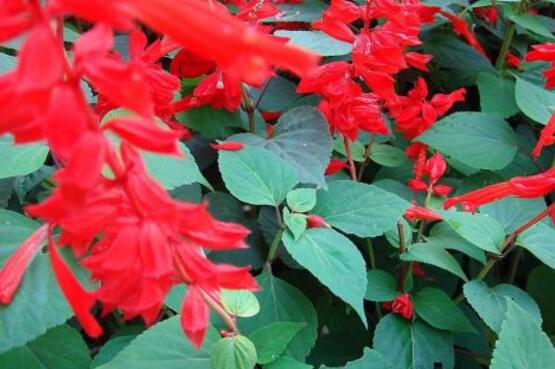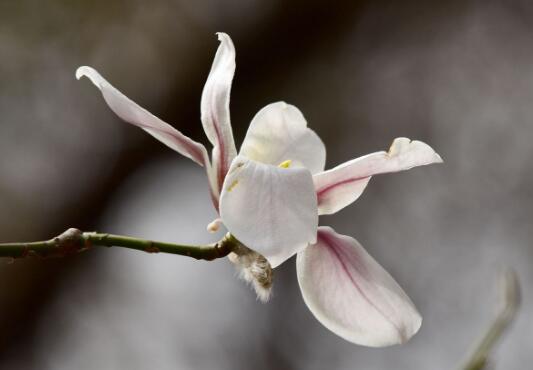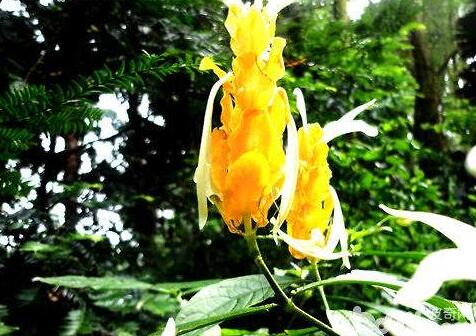Is a string of red poisonous? can a string of red be put indoors / non-toxic / suitable for indoor culture
A string of red is also known as ivory red, because it is a plant of the sage family, so many flower lovers are worried about its safety, because some plants of sage will cause discomfort when they are planted, so is a string of red poisonous? Can I put a string of red inside? Next, the editor will give you a detailed answer.
Is a string of red poisonous
1. Planting and ornamental / non-toxic

Saffron is cultivated all over the world, and it is the most commonly cultivated herbal flower in China. It can be found in parks, flower beds, courtyards and many other places. When people watch and plant it, there are no symptoms of poisoning. Therefore, most flower friends think that it is a non-toxic plant.
2. Is a string of red edible / edible
Watching or planting will not come into contact with a string of red juice, but eating is different, so a string of red can be eaten? The answer is edible, but only in moderation. A string of red decoction can clear heat and detoxification, reduce swelling and pain, and treat stomachache, rheumatism and other symptoms, but if taken in large quantities may cause adverse reactions.
3. A string of safflower nectar
A bunch of red flowers are bright red, its base is rich in nectar, it is also edible, sweet and tastes good, of course, it is best to pick fresh nectar, and to avoid excessive, even if it has certain medicinal effects, if excessive can also produce side effects.
Can I put a string of red inside?
1. The plant height is about 90 cm.
The size of the plant cultivated indoors should be appropriate. If it is too high, it is not suitable for potted plants to be raised indoors. A string of red plants is usually about 90 cm high, so it is very suitable for potted plants to grow indoors, which can beautify the environment and ornamental effect. This is also one of the functions of a string of red plants.
2. Safe and non-toxic
A string of red is a non-toxic plant, its branches and leaves are non-toxic, the smell is also non-toxic, and there is a faint fragrance when the flowers bloom, making the indoor environment more comfortable, people can ease the mood while watching, and improve our rest, work and school efficiency.
The planting method of a string of red
1, substrate: choose fertile, loose soil, PH value is about 6, do not use alkaline soil to plant a string of red, can be made of rotten leaf soil, fine sand, garden soil and so on mixed into the matrix, the need to disinfect the soil before use.
2, light and temperature: ensure adequate light, avoid lack of light and cause steep growth of leaves, but avoid direct sunlight in summer, otherwise leaves are easy to burn and not blossom. The temperature should be kept between 15-30 degrees, because a string of red is not hardy, so we should pay attention to heat preservation in winter.
3. Fertile water: watering is based on the principle of thoroughly watering and no stagnant water, and watering is based on the wetness of the soil. The criterion is whether the soil surface is white or not, and less watering is needed in winter. Fertilization also needs to be flexibly adjusted according to the growth situation, fertilization can be applied once every 2-3 weeks in the growth period, and stop fertilization in the dormant period.
Reasonable cultivation of indoor flowers, create a clean and warm home, reasonable cultivation of indoor flowers, create a clean and warm home in the fast-paced modern urban life, people call for the green design of the home environment. Look forward to the emotional connection between green plants and interior decoration in interior design to create poetic and picturesque feelings. When you get home from a day of intense work, you can smell its fragrance and watch its vitality, which is the aesthetic requirement of modern human "health design". On the other hand, with the improvement of people's living conditions, the housing of most urban residents has been able to separate the bedroom, study, foyer, kitchen and toilet, providing conditions for indoor green plant decoration. Green decoration has become an important part of indoor soft decoration, it can not only soften the hard lines of the building, make people get psychological adjustment, spiritual relaxation, but also improve indoor air quality. To form a green field of vision and improve human health, green plants can make people pleasing to the eye, edify sentiment and purify the soul. The ornamental function of plant interior decoration meets people's psychological requirements. A good indoor environment can also make people relax in stressful work. Green accounts for 25% of the human field of vision, can eliminate the physical fatigue of the eyes, for the human spirit and psychology is the most suitable; some plants can secrete gaseous aromatic terpenes, patients after inhalation, can stimulate the nerve center, stimulate the corresponding functional organs, play the role of diuresis, anti-inflammation and strengthen breathing. Purifying the air and regulating the indoor climate flowers and plants can effectively purify the indoor air and keep the air fresh and natural. Most flowers carry out photosynthesis during the day, absorbing carbon dioxide, releasing oxygen, breathing at night, absorbing oxygen and releasing carbon dioxide. Cactus succulent plants, on the other hand, close the stomata during the day to avoid water loss, and the oxygen produced by photosynthesis is released only after the stomata are opened at night. Keeping the flowers with complementary functions in the same room can not only make the two mutually beneficial, but also balance the content of indoor oxygen and carbon dioxide, and keep the indoor air fresh. After absorbing water, indoor plants lose water to the air through leaf transpiration, which can play a role in moisturizing the air. The fragrance emitted by plants such as lemon and jasmine can change the listless state caused by monotonous work; the fungicides secreted by flowers such as jasmine, cloves, honeysuckle and morning glory can kill some bacteria in the air, inhibit the growth of tuberculosis, dysentery pathogens and typhoid bacteria, and make the indoor air clean and hygienic. Absorb harmful chemicals to prevent indoor air pollution some flowers have strong anti-toxic ability, can absorb a certain concentration of toxic gases in the air, such as sulfur dioxide, nitrogen oxides, formaldehyde, hydrogen chloride and so on. Camellia, cyclamen, iris, violet, evening fragrant jade, impatiens, morning glory, carnation, gladiolus and so on absorb highly toxic sulfur dioxide through leaves and convert them into non-toxic or low toxic sulfate by oxidation. Daffodils, purple jasmine, chrysanthemum, cockscomb, Saxifraga, Saxifraga, etc., can convert nitrogen oxides into plant cell proteins. Hanging orchid, aloe, tiger tail orchid can absorb a large number of indoor formaldehyde and other pollutants, eliminate and prevent indoor air pollution. Excessive concentration of certain chemicals in the air of new homes can cause headaches, dizziness, runny nose, insomnia, fatigue, joint pain and loss of appetite, which is medically known as "new home syndrome". In order to eliminate the "new home syndrome", in addition to keeping the room clean and ventilated, another effective way is to put some green plants such as evergreen, hanging orchid, rose, lily, palm, geranium and so on. These plants and flowers contain volatile oils, which all have significant bactericidal functions, especially foliage plants such as Cymbidium and flowers and trees of Azaleaceae, which have the effect of absorbing radioactive materials. Flower counter on the second floor of Zhangqiuhua Lianquan Mountain Yipin Shop "three suitability and two taboos" for indoor planting at the flower counter of the shopping mall in Zhangqiu Hualian Development Zone
Now more and more friends like to plant some flowers at home to improve the environment, but also to beautify the home, it can be said that there are many benefits, but do you know that growing flowers at home actually has "three suitability and two taboos".
Cockscomb flower
First, "three suitability" for planting flowers in the house.
1. Flowers with strong ability to absorb toxins can absorb a certain concentration of toxic gases in the air, such as sulfur dioxide, nitrogen oxides, formaldehyde, hydrogen chloride and so on. Camellias, cyclamen, irises, violets, evening fragrant jade, impatiens, morning glory, carnation, gladiolus, etc., absorb highly toxic sulfur dioxide through leaves and convert them into non-toxic or low toxic sulfates by oxidation; daffodils, purple jasmine, chrysanthemum, cockscomb, red, Saxifraga and other proteins that can convert nitrogen oxides into plant cells. Hanging orchid, aloe, tiger tail orchid can absorb a large number of indoor formaldehyde and other pollutants, eliminate and prevent indoor air pollution.
2. Suitable flowers that can secrete fungicides: the fungicides secreted by flowers such as jasmine, cloves, honeysuckle and morning glory can kill some bacteria in the air, inhibit the growth of tuberculosis, dysentery pathogens and typhoid bacteria, and make the indoor air clean and hygienic.
3. It is appropriate to plant flowers with complementary functions. Most flowers photosynthesize during the day, absorb carbon dioxide, release oxygen, breathe at night, absorb oxygen and release carbon dioxide, while cacti release carbon dioxide during the day and absorb carbon dioxide at night. Release oxygen. Keeping flowers with complementary functions in the same room can not only make the two mutually beneficial, but also balance the content of indoor oxygen and carbon dioxide, and keep the indoor air fresh.
Second, "two taboos" of planting flowers in the house
1. Avoid a variety of flowers that send out strong fragrance and irritating smell: orchids, roses, roses, lilies and nocturnal incense will exude rich gas. If you put too many fragrant flowers in the room and the fragrance is too strong, it will excite people's nerves, especially in the bedroom for a long time, will cause insomnia. The gas emitted by Christmas flowers, evergreen and oleander is harmful to people, let alone be imported. Tulips, hydrangea emitted by the particles contact for a long time, the skin will be allergic, itchy.
2, avoid putting too many flowers, most flowers at night will release carbon dioxide, absorb oxygen, compete with people, and most of the rooms at night are closed, and the airflow is not enough to circulate with the outside world, if there are too many flowers in the room, it will increase the concentration of indoor carbon dioxide and cause hypoxia in the human body.
- Prev

Is Magnolia poisonous? can Magnolia be cultivated indoors / non-toxic can be raised indoors?
Magnolia is a kind of plant with simple and elegant appearance, which gives people a very comfortable feeling, so it is loved by many people, and many people want to raise one at home. However, many plants are toxic to a certain extent, which we need to know before breeding. Is magnolia poisonous?
- Next

When does the golden bract blossom? what if the golden bud does not blossom / with a solution
Golden bracts flower language has the meaning of a hundred years of harmony and prosperity, so it not only has a strange flower shape, but also has a very beautiful flower language, and many people choose to plant it because of its long flowering period.
Related
- Fuxing push coffee new agricultural production and marketing class: lack of small-scale processing plants
- Jujube rice field leisure farm deep ploughing Yilan for five years to create a space for organic food and play
- Nongyu Farm-A trial of organic papaya for brave women with advanced technology
- Four points for attention in the prevention and control of diseases and insect pests of edible fungi
- How to add nutrient solution to Edible Fungi
- Is there any good way to control edible fungus mites?
- Open Inoculation Technology of Edible Fungi
- Is there any clever way to use fertilizer for edible fungus in winter?
- What agents are used to kill the pathogens of edible fungi in the mushroom shed?
- Rapid drying of Edible Fungi

